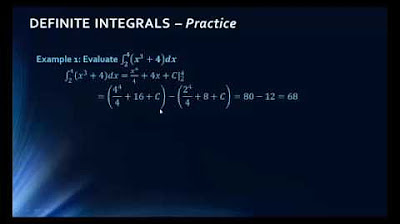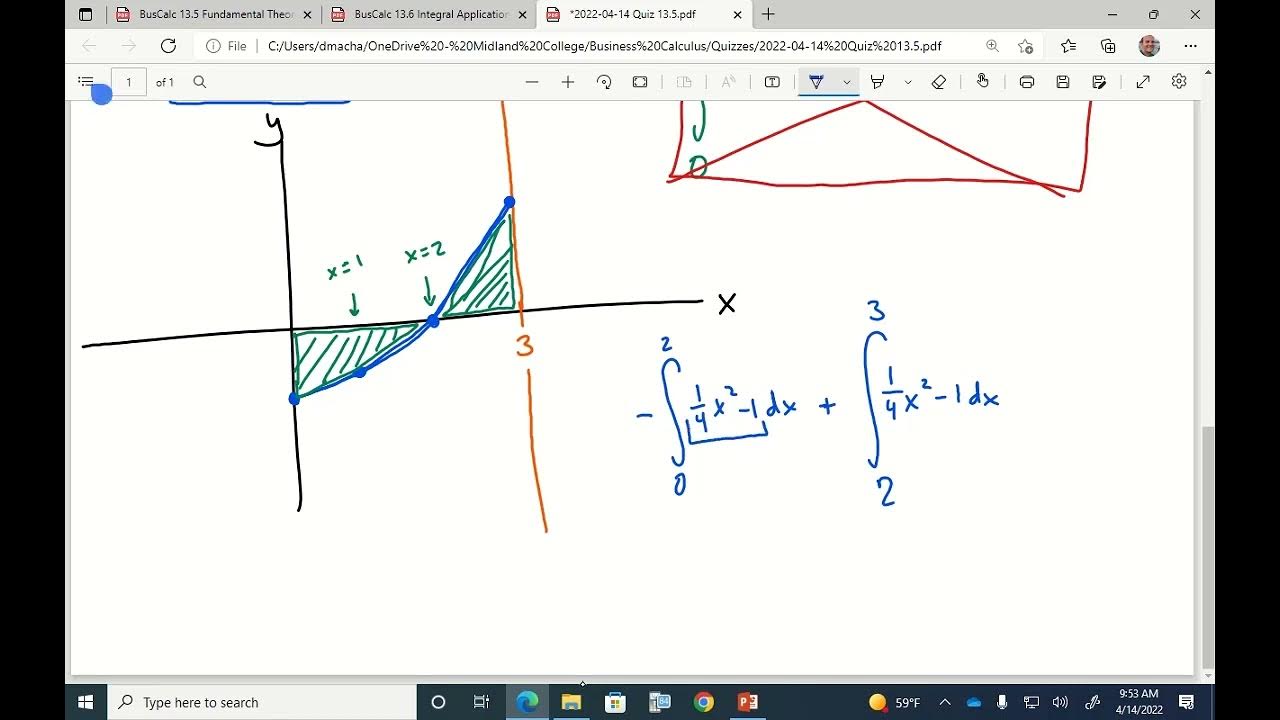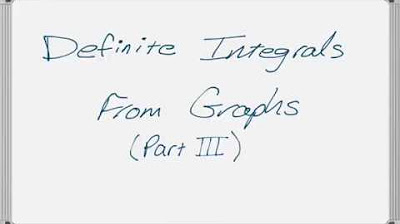Worked example: Merging definite integrals over adjacent intervals | AP Calculus AB | Khan Academy
TLDRThe video script discusses the concept and evaluation of definite integrals using a graph of a function and the areas between the curve and the x-axis. It illustrates the process with examples, showing how to calculate the sum of integrals from different intervals and how the properties of definite integrals can simplify the process. The examples demonstrate the addition of integrals with the same function and how to handle areas below the x-axis, emphasizing the application of integration properties to merge integrals and find the total area.
Takeaways
- 📊 The script discusses the concept of evaluating definite integrals using the areas under a curve and the x-axis.
- 🌟 The first example involves evaluating the sum of two definite integrals from -4 to -2 and from -2 to 0, which results in the entire area from -4 to 0, but with a negative sign.
- 🔄 An important property of definite integrals is highlighted: if the upper bound of one integral matches the lower bound of another, and they integrate the same function, the integrals can be combined.
- 🧩 The second example demonstrates how to evaluate the sum of definite integrals from 0 to 4 and from 4 to 6, which simplifies to the integral from 0 to 6.
- 📉 The concept of areas below the x-axis being negative is explained, as these represent the opposite of the usual positive area above the x-axis.
- 🤔 The script encourages the viewer to pause and attempt to evaluate the expressions on their own before revealing the solution.
- 📚 The examples provided in the script are practical applications of the fundamental theorem of calculus, which allows for the computation of definite integrals.
- 🌐 The video script serves as an educational tool for understanding the properties and evaluation of definite integrals.
- 🔢 The final answers to the examples are given as -7 for the first and -1 for the second, emphasizing the importance of correctly identifying the sign of the areas.
- 🏫 The script is likely part of a larger educational content aimed at teaching calculus or integral calculus to students.
- 💡 The use of visual aids, such as a graph, is suggested as a helpful tool for understanding the concepts being discussed.
Q & A
What is the main topic of the video?
-The main topic of the video is evaluating definite integrals using the graph of a function and understanding the properties of definite integrals.
How does the video begin its explanation?
-The video begins by presenting a graph of y = f(x) and discussing the areas of the shaded regions between the curve and the x-axis.
What is the first example the video presents?
-The first example is evaluating the definite integral from x = -4 to x = -2 of f(x) dx, plus the definite integral from x = -2 to x = 0 of f(x) dx.
How does the video suggest to approach the first example?
-The video suggests to approach the first example by considering the areas under the x-axis (since the curve is below the x-axis) and using the property of definite integrals where the upper bound of one integral is the lower bound of the other.
What property of definite integrals is used in the first example?
-The property of definite integrals used in the first example is that if the upper bound of one definite integral is the same as the lower bound of another, and they are integrating the same function, the integrals can be merged.
What is the result of the first example?
-The result of the first example is that the sum of the two definite integrals is equivalent to the definite integral from x = -4 to x = 0 of f(x) dx, which evaluates to the negative of the entire area under the x-axis, and is given as -7.
How does the second example in the video start?
-The second example starts with a hypothetical scenario where someone shows a graph and asks for the value of the definite integral from x = 0 to x = 4 of f(x) dx, plus the definite integral from x = 4 to x = 6 of f(x) dx.
What is the key insight for solving the second example?
-The key insight for solving the second example is recognizing that the sum of the two definite integrals can be rephrased as a single definite integral from x = 0 to x = 6 of f(x) dx, and understanding how to handle the area below the x-axis.
What is the final result of the second example?
-The final result of the second example is that the sum of the two definite integrals evaluates to the area from x = 0 to x = 4 (which is 5) plus the negative of the area from x = 4 to x = 6 (which is -6), resulting in a total of -1.
What is the significance of the definite integral properties discussed in the video?
-The significance of the definite integral properties discussed in the video is that they provide a systematic way to evaluate and combine integrals, even when the limits of integration are not immediately obvious or when the function is below the x-axis.
How can the concepts from the video be applied to other integral problems?
-The concepts from the video can be applied to other integral problems by recognizing patterns in the limits of integration and applying the properties of definite integrals to simplify and evaluate complex expressions, especially when dealing with areas above or below the x-axis.
Outlines
📚 Introduction to Evaluating Definite Integrals
The video begins with an introduction to the concept of definite integrals, where the instructor presents a graph of a function y = f(x) and discusses the areas of the shaded regions between the curve and the x-axis. The aim is to evaluate definite integrals using the given information and properties of integrals. An example is provided to illustrate the process of evaluating the definite integral from negative four to negative two of f(x) dx, and then adding it to the integral from negative two to zero. The instructor explains how to combine these integrals by utilizing the properties of integration, especially when the upper bound of one integral matches the lower bound of the other, resulting in the sum of the areas between the curve and the x-axis over the given interval. The example concludes with the evaluation of the expression yielding a result of negative seven.
Mindmap
Keywords
💡definite integrals
💡graph of y=f(x)
💡shaded regions
💡properties of definite integrals
💡area
💡x-axis
💡negative area
💡integration
💡upper bound
💡lower bound
💡sum of definite integrals
Highlights
The video discusses evaluating definite integrals using the graph of a function and the areas between the curve and the x-axis.
A method for evaluating definite integrals is demonstrated through examples using knowledge of integral properties.
The first example involves evaluating the definite integral from negative four to negative two and then from negative two to zero.
When the curve is below the x-axis, the area is considered negative in the context of definite integrals.
An integral property is introduced where definite integrals with the same upper and lower bounds can be merged.
The area below the x-axis and above the curve is calculated as the negative of the area above the x-axis.
The second example involves evaluating the definite integral from zero to four and then from four to six.
The sum of areas below the x-axis and above the curve can be challenging to estimate without exact values.
The expression involving the sum of two definite integrals can be simplified to a single definite integral over the entire range.
The video emphasizes the importance of understanding the properties of definite integrals for problem-solving.
The area above the x-axis is added to the calculation, while the area below is subtracted, reflecting the signed nature of definite integrals.
The final answer of the second example is derived by combining the areas and accounting for their positions relative to the x-axis.
The video provides a practical approach to visualizing and calculating definite integrals from a graphical perspective.
The process of evaluating definite integrals involves understanding the function's behavior in relation to the x-axis.
The video concludes with the correct evaluation of the second example, resulting in a final answer of negative one.
The transcript serves as a comprehensive guide for learners to understand the concepts and techniques of evaluating definite integrals.
Transcripts
5.0 / 5 (0 votes)
Thanks for rating:





